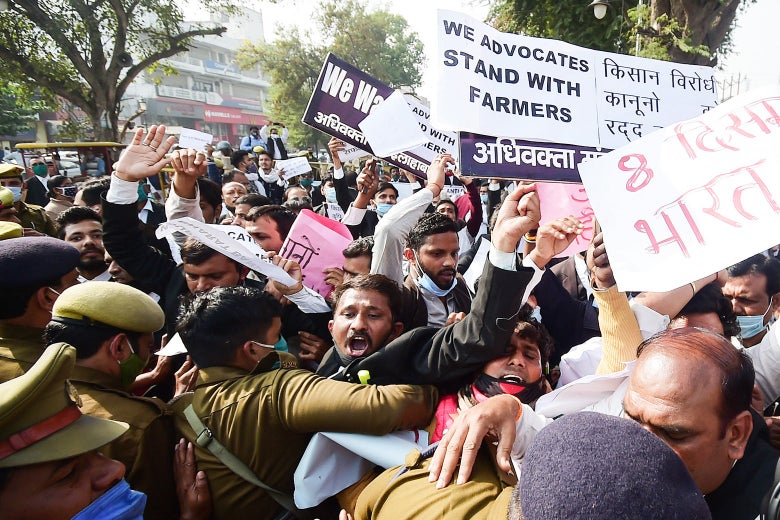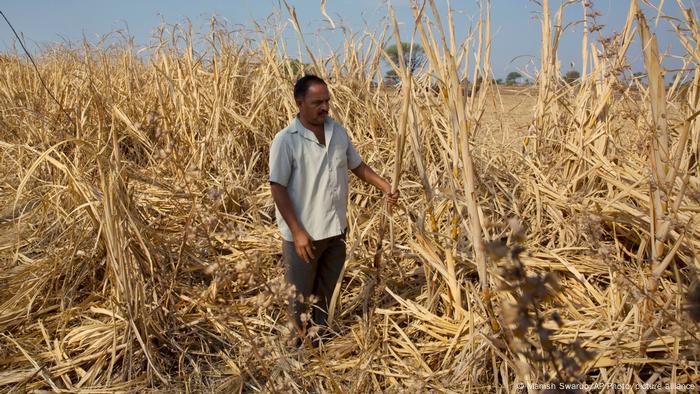‘We want dignity’: Indian farmers defy pellets, drones to demand new deal
Two years after they brought the Indian capital to a standstill, farmers say Prime Minister Narendra Modi’s government has betrayed its promises.
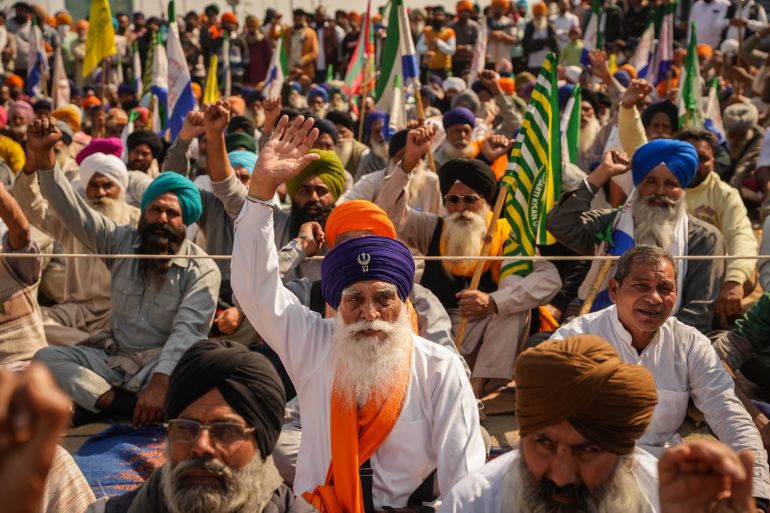
By Rifat Fareed
21 Feb 2024
Shambhu border, India — Balvinder Singh lies on his side, writhing in pain, on a hospital bed in the northern Indian state of Punjab.
When Singh, 47, was hit by a volley of piercing objects while marching towards New Delhi with thousands of other farmers, he did not know what had struck him.
But his body is pockmarked with telltale black scars from iron pellets fired by security forces to prevent farmers from crossing over from Punjab into the state of Haryana, which borders New Delhi. Haryana is ruled by Prime Minister Narendra Modi’s Bharatiya Janata Party, whose federal policies the farmers are protesting against.
Singh, a farmer from Faridkot district in Punjab, who was admitted at Rajindra Hospital in the city of Patiala, was hit when he was calming the angry young farmers at the front of the protest site, metres away from the border on February 14, a day after the protests began.
“I was calming down the protesters when I was hit,” Singh says, his left eye bloody from a pellet injury. “I could not understand whether it was a bullet or something else that hurt me.”
Singh says he had never heard of iron pellets being used as ammunition by security forces against civilian protesters. In the past, such pellets have been mostly used in Indian-administered Kashmir as a crowd-control mechanism. Pellet guns have blinded scores of people in Kashmir.
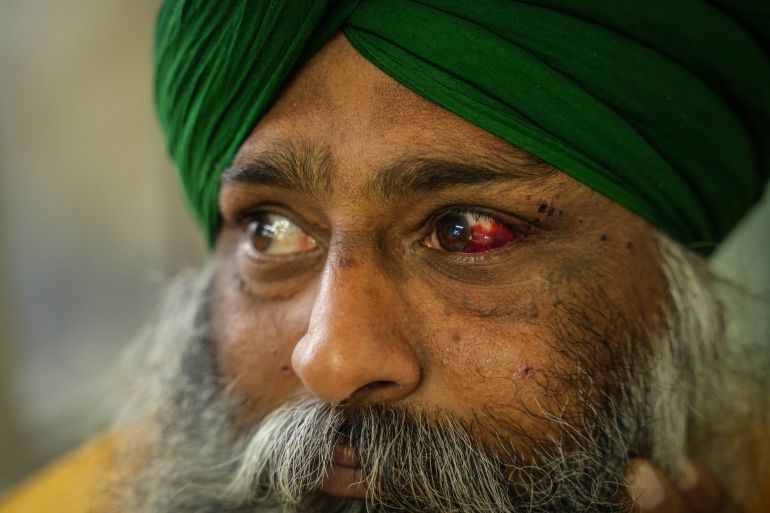
Now, they are part of the intensifying confrontation between farmers and the government. The government in Punjab, which is ruled by the Aam Aadmi Party that is in opposition nationally, has said that three farmers have lost their eyesight after being hit with the Haryana police pellets and a dozen others have also suffered pellet injuries.
Critics of the farmers, meanwhile, argue that the central government cannot allow the protests to escalate the way they did in 2021, when clashes broke out on the streets of New Delhi. Some protesters reached the Red Fort – from where the prime minister delivers the Independence Day speech – and were accused of yanking down the national flag. A security crackdown followed.
Yet, days after this latest agitation kicked off, there are growing signs of a repeat of the kind of escalation in tensions that India witnessed three years ago.
Thousands of farmers in their tractor trolleys, small trucks, on foot, and scooters have travelled from rural areas of Punjab and gathered on the Punjab-Haryana highway waiting to march on the capital city. They are hoping to press the BJP government for demands including a guaranteed minimum support price (MSP) for their crops and loan waivers, among others.
In Haryana, the government has been criticised for using drones to drop tear gas shells on the protesting farmers. The state’s police have sealed the border with heavy cemented blocks, iron nails and barbed wire.
Singh, who owns a four-acre plot where he grows rice and wheat, says there is no guarantee of price in the fluctuating market for other crops.
“We spend more on cultivation [when growing other crops] and there is no earning,” he says.
“Now, we are also facing water shortages for even growing these two crops [rice and wheat]. We are in deep stress.”
At present the government buys rice and wheat from farmers for public distribution, and offers them a minimum support price for these grains. But other agricultural commodities do not receive this price protection. That, farmers say, has in turn led to the overproduction of rice and wheat. Paddies in particular, are water intensive, leading to depleted groundwater levels.
“If I want to diversify to other crops, there should be financial security for me that I will get a good price – that is what we are asking. We are asking for our rights,” says Singh, from the hospital, where eight other farmers, some aged above 60, are also being treated.
One of them, Mota Singh, 32, from Hoshiarpur in Punjab, said that he was hit by a rubber bullet on his hand. To Mota, something even more fundamental is at stake than crop prices.
“Farmers are demanding dignity, we cannot be poor forever,” says Mota, when asked why he was protesting.
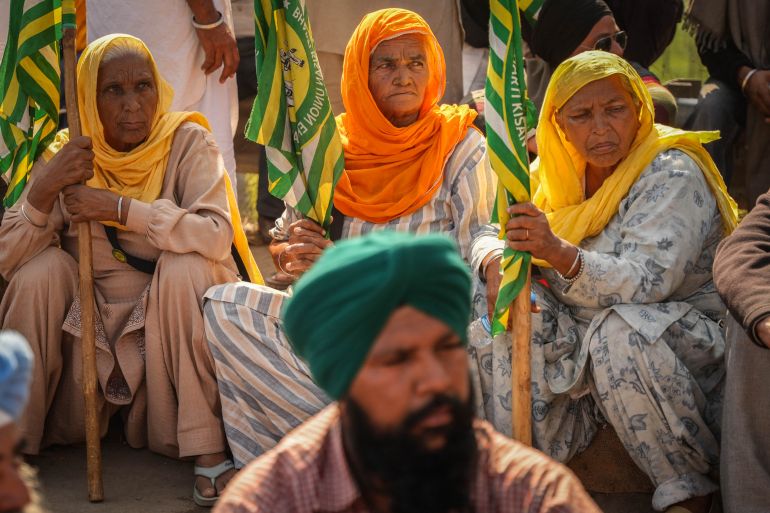
Why are farmers again on the roads?
More than 250 farmers’ unions have supported the protest that is being organised from Punjab.
Up to two-thirds of India’s 1.4 billion population are engaged in agriculture-related activities for their livelihoods and the sector contributes nearly a fifth of the country’s gross domestic product.
Farmers say that their main demand – minimum support price legislation – would ensure that the rates of their crops are sustainable and provide them with decent earnings.
At present, the government protects wheat and rice against the price fall by setting a minimum purchase price, a system that was introduced more than 60 years ago, to ensure food security in India.
Development economist Jayati Ghosh says that if other crops were also brought under the MSP regime, it would help provide sustainable financial support to the farmers. This wouldn’t mean that the government would need to buy large volumes of these crops, says Ghosh, a professor at the University of Massachusetts Amherst.
It’s only when the price drops below the MSP that the government would need to step in and buy just enough that the price rises above the minimum set bar, she says.
“It’s a market intervention that makes sure that farmers have this other option,” Ghosh says.
In India, experts say that agriculture has been going through a severe crisis due to increasing extreme weather combined with a lowering water table, affecting yields and pushing farmers deep into debt. Thousands of farmers take their own lives each year. In 2022, data collected by the National Crime Records Bureau (NCRB) shows that 11,290 farmers died by suicide.
Ghosh questions why the government is reluctant to write off farm loans.
“Every year the banking system writes off loans of lakhs of crores (billions of dollars) of money taken by large corporations and that is not even mentioned and it is not even news,” she says. “The corporations can get away with all kinds of loan waivers but the farmers are asking a small fraction of that and … are treated as criminals.”
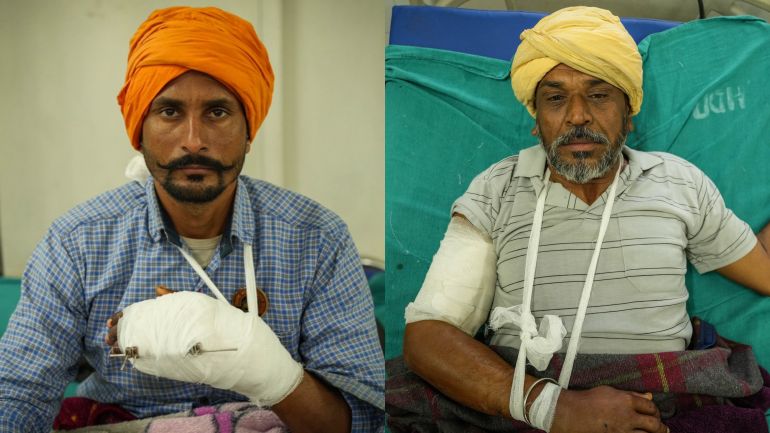
‘Government not honouring its promises’
The farmers are also demanding that the Modi government withdraw cases filed against them during the last protest in 2020-21.
Held on the outskirts of New Delhi for 13 months, those protests were against a set of three farm laws brought in by the BJP government that aimed to push India’s family-based, smallholdings-driven farm sector towards privatised and industrialised agriculture.
The government argued that the laws would improve market competition and in turn bring new wealth, especially to smaller farmers. But farmers protested, worried that the laws would leave them at the mercy of big corporations.
Eventually, Modi agreed to repeal the laws, and his government said it would set up a panel of stakeholders to find ways to ensure support prices for all produce.
The protesting farmers now accuse the government of not honouring those promises. And they are readying for a long wait to pressure the government.
Hardeep Singh, 57, from Gurdaspur in Punjab, has come prepared with bags of rice, flour, and other essentials in his tractor.
“We are here even if it takes months,” says Hardeep, who left his home with dozens of other villagers on February 11.
“We might not be allowed to go forward but we will not go backward, either.”

Darshan Singh, 66, sits silently on the side of the highway. He carries a passport-size photo of his son, 27-year-old Gurpreet Singh, in his wallet.
Gurpreet was among more than 700 farmers who died during the previous farmers’ protest in 2021.
“He was at the protest site for a year. He fell sick at the site and died after returning to the village. We are giving sacrifices for this movement,” Darshan tells Al Jazeera. But that tragedy has not deterred the father from joining the protest this time. “I am not afraid of losing my health here.”
Darshan says he wants justice for the two children and young wife his son left behind.
With national elections in India just two months away, the farmers are trying to ensure that they cannot be ignored. Because of their sheer numbers, farmers constitute a significant chunk of Indian voters.
The ruling BJP government recently conferred the nation’s highest civilian award on MS Swaminathan, a pioneer of the agricultural revolution in the 1960s and 1970s. Meanwhile, the opposition Congress party has promised to legalise an MSP on crops if elected to power.
A government delegation has been engaged in negotiations with the protesting farmers without a breakthrough.
“We feel the government wants to suppress us and pass time,” Manjeet Singh, a leader of Bhartiya Kisan Union Shaheed Bhagat Singh, a local farmers’ union from Haryana, told Al Jazeera.
A fourth round of talks on Sunday evening, held between a 14-member farmers’ delegation and government representatives, including three federal ministers, failed to yield a breakthrough.
The government has offered farmers MSP for pulses, cotton and maize. The crops, according to the proposal, would be bought by the government agencies on an agreement for five years.
But the farmers have rejected the offer, which they argue only temporarily addresses their demand – unlike a law that would guarantee them MSP for these commodities in the long run. The farmers say they will continue with their protest march to New Delhi.
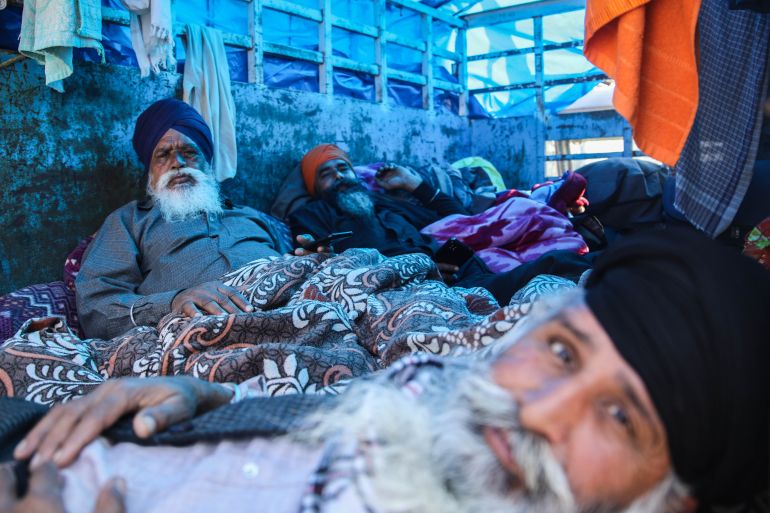
Devinder Sharma, a food and agricultural expert based in Chandigarh, the capital of both Punjab and Haryana, says that the farmers’ demands have merit.
“We have deliberately kept agriculture impoverished,” he says, adding that an MSP law could provide an unprecedented economic boom for the country by improving the income of a majority of the nation’s families that depend on agriculture.
He is not surprised at the pushback the farmers are facing from critics, mostly in the cities, though.
“The problem is when the prices go up the corporate profit is reduced. The (corporates) want to ruthlessly exploit farmers and I think enough is enough,” he says.
“Why can’t farmers be prosperous?”
SOURCE: AL JAZEERA

A farmer wears a makeshift mask to protect himself from tear gas fired by the police, at the site where farmers are marching towards New Delhi to press for better crop prices promised to them in 2021, at Shambhu barrier, a border crossing between Punjab and Haryana states, India, Feb 21, 2024.
PHOTO: Reuters
FEBRUARY 21, 2024
SHAMBHU, India — Indian police fired tear gas on Wednesday (Feb 21) to scatter protesting farmers as they resumed a march to the capital, equipped with cranes and excavators after talks with the government on guaranteed prices for their produce failed to break a deadlock.
To escape the stinging gas and clouds of smoke, thousands of farmers, some wearing medical masks, ran into the fields surrounding their gathering-point on a highway about 200 km north of New Delhi.
The police action came as the government of Prime Minister Narendra Modi made a fresh offer to resume talks on the farmers' demands. Agriculture Minister Arjun Munda urged the farmers to resolve their grievances through the talks.
"After the fourth round, the government is ready to discuss all the issues" such as guaranteed prices, he posted on social network X, as the march resumed.
"I again invite the farmer leaders for discussion. It is important for us to maintain peace."
On Monday, the farmers' groups had rejected the government's previous proposal for five-year contracts and guaranteed support prices for produce such as corn, cotton and pulses.
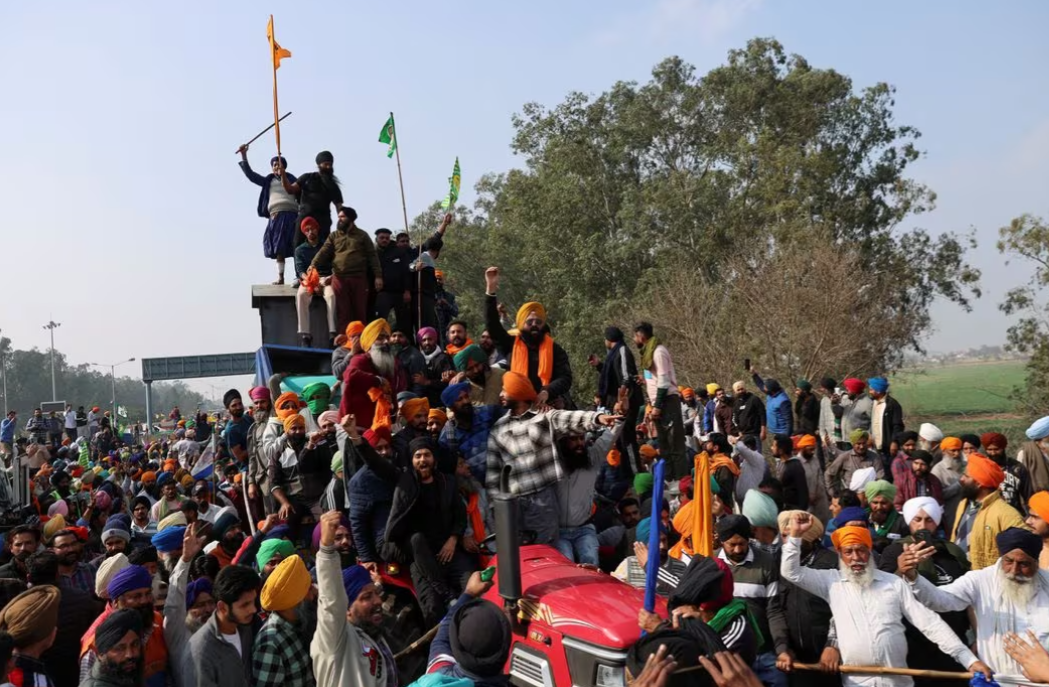
PHOTO: Reuters
The farmers, mostly from the northern state of Punjab, have been demanding higher prices backed by law for their crops. They form an influential bloc of voters Prime Minister Narendra Modi cannot afford to anger ahead of general elections due by May.
Sticks, stones, gas masks
The farmers began marching at 0530 GMT from the spot where authorities had stopped them by erecting barricades on the border of Punjab state with Haryana, blocking a key highway.
"It is not right that such massive barricades have been placed to stop us," said one of the farmers' leaders, Jagjit Singh Dallewal. "We want to march to Delhi peacefully. If not, they should accede to our demands."
Police in riot gear lined both sides of the highway as the farmers, gathering earlier amid morning fog, waved colourful flags emblazoned with the symbols of their unions, while loudspeakers urged them to fight for their rights.
Television images showed some wearing gas masks.
Late on Tuesday, Haryana police's chief ordered the immediate seizure of the heavy equipment brought by the farmers, to prevent its use by protesters in destroying barricades.
Police also asked owners of such equipment not to lend or rent it to protesters, as its use to harm security forces would be a criminal offence.
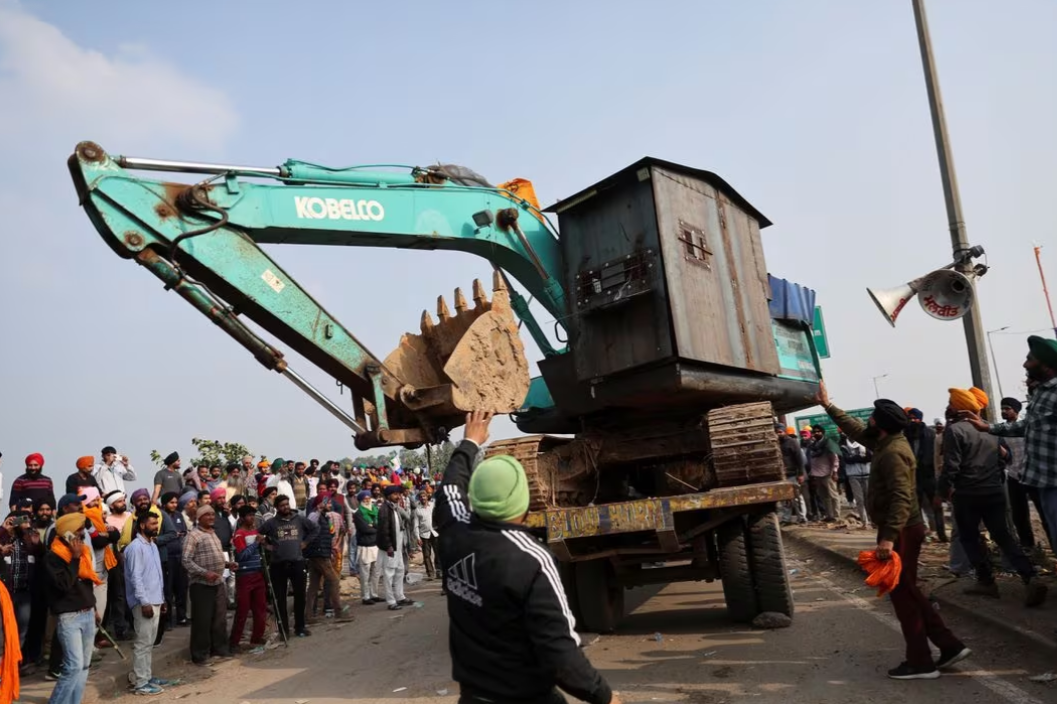
PHOTO: Reuters
About 10,000 people had gathered on Wednesday, along with 1,200 tractors and waggons at Shambhu on the state border, police in Haryana posted on X, warning against the risk of stone-throwing as they were armed with sticks and stones.
Sunday's government proposal of minimum support prices to farmers who diversify their crops to grow cotton, pigeon peas, black matpe, red lentils and corn was rejected by the protesters, who wanted additional foodgrains covered.
Similar protests two years ago, when farmers camped for two months at the border of New Delhi, forced Modi's government to repeal a set of farm laws.
ALSO READ: Protesting farmers clash with security forces 200km from New Delhi
Source: Reuters
Police fire teargas as Indian farmers resume protest march to New Delhi after talks fail
Police have fired tear gas at thousands of Indian farmers who resumed their protest march to New Delhi after talks with the government failed to end an impasse over their demands for guaranteed crop prices
SHAMBHU, India -- Police fired tear gas on Wednesday at thousands of Indian farmers who resumed their protest march to New Delhi after talks with the government failed to end an impasse over their demands for guaranteed crop prices.
The protests come at a crucial time for India, where national elections are due in the coming months and Prime Minister Narendra Modi’s party is widely expected to secure a third successive term in office.
The farmers began their protest last week but were stopped some 200 kilometers (125 miles) from the capital. Authorities are set on containing the protest, which has renewed the movement from over two years ago when tens of thousands of farmers had camped out on the outskirts of the city for over a year.
At the time, the farmers pitched tents, bought food supplies and held out in the sit-in until they forced Modi to repeal new agriculture laws in a major reversal for his government.
This time around, the authorities have barricaded the highways into New Delhi with cement blocks, metal containers, barbed wire and iron spikes to prevent the farmer from entering.
On Wednesday, the farmers arrived at the barricades with bulldozers and excavators to try and push through.
Jagjit Singh Dallewal, one of the farmers leading the march, said they did not want any violence, but condemned the federal government over the massive security measures.
“It is our request that we want to go to Delhi in a peaceful manner. The government should remove the barricades,” he said.
Last week, the farmers had paused their protest and hunkered down near the town of Shambhu, close to the border between Punjab and Haryana states, as farmers unions engaged in discussions with government ministers.
They rejected a proposal from the government that offered them five-year contracts of guaranteed prices on a set of certain crops, including maize, grain legumes and cotton, and the farmers resumed their march on Wednesday.
The protest organizers say the farmers are seeking a new legislation that would guarantee minimum prices for 23 crops.
The government protects agricultural producers against sharp falls in farm prices by setting a minimum purchase price for certain essential crops, a system that was introduced in the 1960s to help shore up food reserves and prevent shortages. The system can apply up to 23 crops, but the government usually offers the minimum price only for rice and wheat.
The farmers say guaranteed minimum support price for all 23 crops would stabilize their income. They are also pressing the government to follow through on promises to waive loans and withdraw legal cases brought against them during the earlier 2021 protests.
Several talks so far have failed to break the deadlock. But Arjun Munda, one of the ministers negotiating with the farmers, said they were willing to hold another discussion and that the government wanted to maintain peace.
“It is the prime minister’s responsibility, who has been elected with majority votes, to handle the situation and accept our demands,” Sarwan Singh Pandher, a farm leader, told the Press Trust of India news agency.
The farmers are an influential voting bloc and particularly important to Modi’s base — especially in Northern Haryana and several other states with a substantial farming population that are ruled by his Bharatiya Janata Party.
___
Pathi reported from New Delhi.
Thousands of Indian farmers prepare to continue march on Delhi
They are demanding higher prices backed by law for their crops
from the government
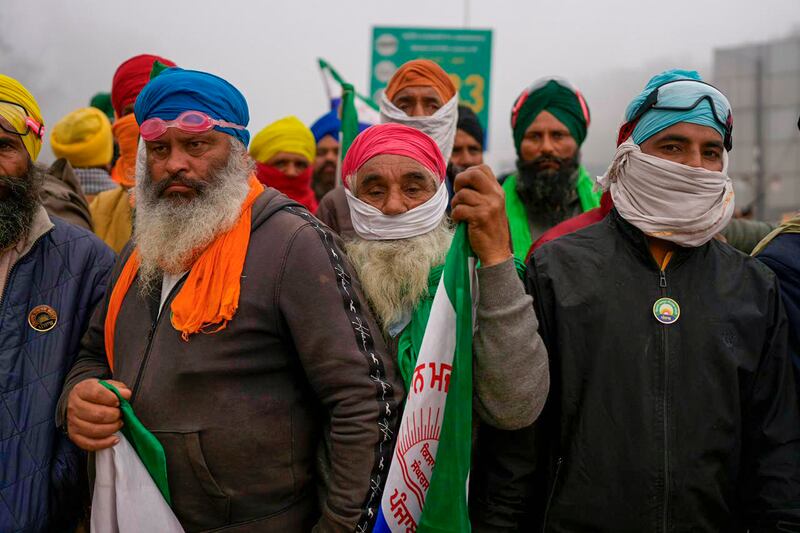
Thousands of Indian farmers prepared to march on the capital on Wednesday to pressure Prime Minister Narendra Modi’s government to meet their demands.
Last week, farmers from Punjab and Haryana, the states responsible for 60 per cent of India's wheat production, started their journey to New Delhi on foot and by tractors. However, they were halted about 200km from their destination by road blockades erected by police and paramilitary forces.
The farmers waited while representatives held talks with the government but decided to press on with their march after a meeting on Monday ended without agreement on their main demand of minimum supports prices for their crops.
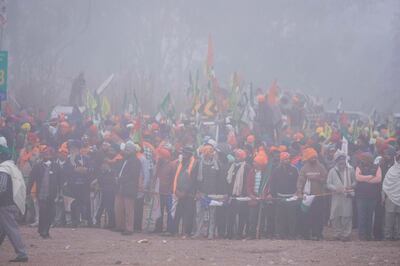
Braving the cold and rain, farmers stood on a bridge over the Ghaggar river on Wednesday morning amid preparations to push through barricades. The bridge is on a motorway that passes from Punjab through Haryana, ruled by Mr Modi's Bharatiya Janata Party, to Delhi.
The motorway was blocked when farmers from the two states launched a sit-in in 2020 after they were stopped from entering Delhi to protest.
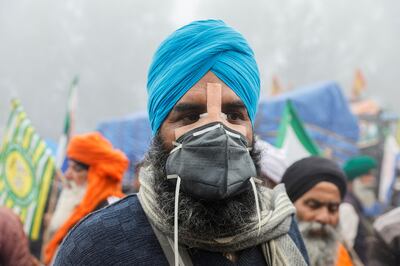
Authorities brought in more than 700 more security personnel and dug trenches to prevent the farmers moving forward. Internet and SMS services were cut off in Haryana.
“We are not scared of the authorities. Last time, we protested for a year. This time around, if they don’t fulfil our demands, we will spend our entire lives here protesting for our rights,” Jaspreet Singh, a farmer from Punjab, told The National.
“We have all the preparations in place to go through the barricade and we still appeal to the government to not use force against us and allow us to go to Delhi which is our constitutional right,” said Manjeet Singh, another farmer.
The farmers have rejected a government offer to buy pulses, maize and cotton at guaranteed prices through cooperatives for five years, saying they want minimum support prices for 23 crops.
The protest has already caused disruption in Delhi, with long traffic jams at entry points to the city where police and paramilitary forces have been posted.

